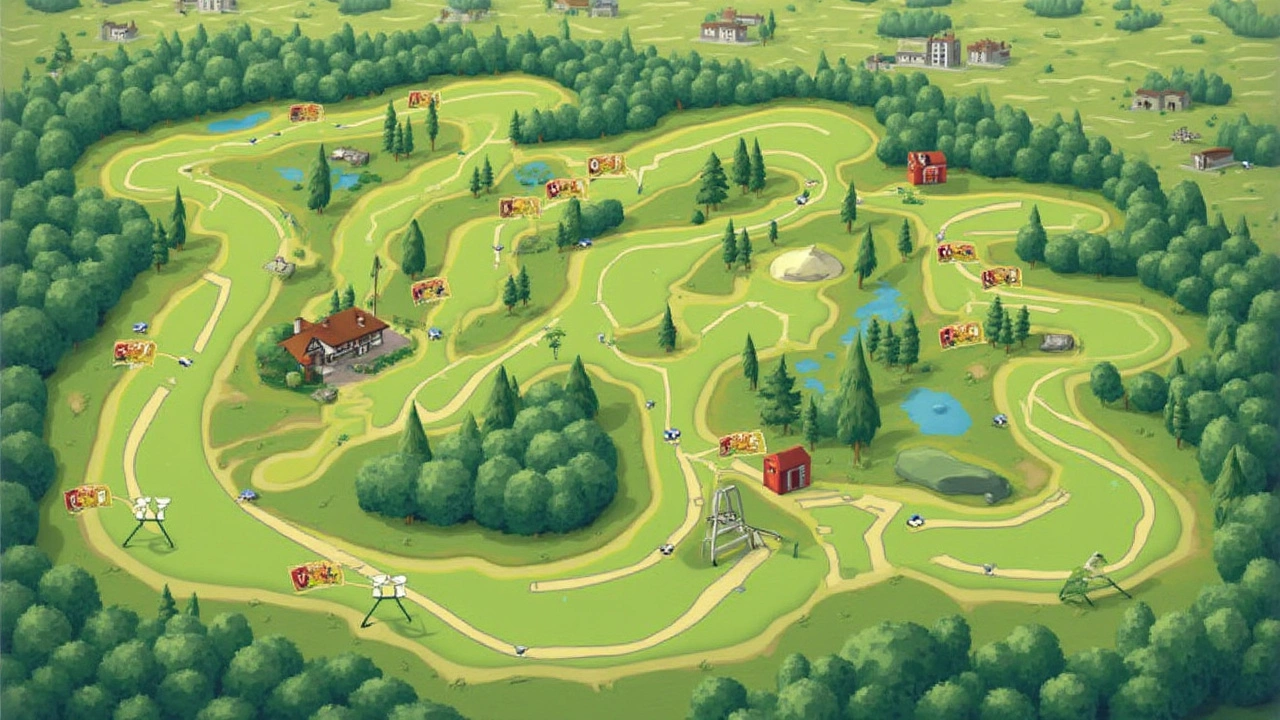Full Course of Golf: What You Really Get When You Play 18 Holes

Ever wondered why golfers talk about 18 holes like it’s the magic number? That’s because a full course of golf almost always has 18 holes—unless you’re squeezing in a short round on a busy day. Golf courses are designed this way for good reason, and once you know what goes into a “full” course, the game makes a lot more sense.
An 18-hole course isn’t just a big piece of land with flags everywhere. Each hole is planned out with different lengths, shapes, and challenges. The idea is to test different shots, not just your ability to hit the ball far. Most courses mix up par-3s, par-4s, and par-5s, which just means how many strokes an expert golfer should take to finish each hole. Expect to walk or ride between 6,000 and 7,000 yards if you play all 18—so comfy shoes are a must.
- What Makes a Full Golf Course?
- Understanding the 18 Holes
- Par: The Scoring Standard
- Variations: 9-Hole and Executive Courses
- Tips for Playing Your Best Round
What Makes a Full Golf Course?
If you ask any regular golfer, they’ll tell you: a full course of golf means 18 holes, plain and simple. This format became the gold standard after the Old Course at St Andrews in Scotland settled on 18 holes back in 1764. It just stuck, and now almost every proper golf course follows that tradition.
A true full course stretches out over a big chunk of land—usually between 100 and 200 acres. You’ll find a mix of holes: some short, some long, some easy, some with serious water hazards or tricky bunkers. The point is variety, so you’re not hitting the same shot over and over.
The usual breakdown for an 18-hole course looks like this:
- Each hole has its own tee box, fairway, and green
- You’ll see a mix: typically four par-3s, ten par-4s, and four par-5s
- The standard full-size course is par 70, 71, or 72—meaning a pro is supposed to finish in that many strokes
- Courses include features like rough, sand traps, water, and trees that demand different shot choices
If you play all 18 holes start to finish in order, that’s a complete round on a full course. Anything less—like just 9 holes—is usually called a “half round.”
There’s also a clubhouse nearby for checking in, a practice green for warming up, and maybe a driving range to hit a few before you start. These extras help make the day smoother, especially if you’re waiting on the group ahead.
Understanding the 18 Holes
If you’ve never played a full course of golf, the idea of 18 holes might seem a little random. But there’s actually a ton of logic behind it. The 18-hole setup dates back to St Andrews in Scotland—the so-called 'home of golf.' When other courses started popping up worldwide, they copied this layout. That’s why, today, when people picture a full round, they’re thinking of 18 distinct and carefully designed holes.
You might be surprised to know that not every hole looks or plays the same. Courses lay out the holes in a mix of pars, lengths, and angles to keep things interesting. Here’s a quick breakdown of what you’ll generally find on a standard course:
- Par-3 Holes: Short, usually between 100 and 220 yards. Great for working on accuracy.
- Par-4 Holes: Mid-length, mostly between 240 and 490 yards. You’ll hit a tee shot, then (hopefully) reach the green with your next stroke.
- Par-5 Holes: Long, anywhere from 450 to 700 yards. These are all about distance and strategy.
The typical ratio is about 4 par-3s, 10 par-4s, and 4 par-5s per course, but it varies a little depending on the style and location. Sometimes there’s an extra par-3, or you might play a course with an unusual setup to fit the land or local tradition.
Here’s a real-world example of how those 18 holes might break down:
| Hole Type | Typical Number per Course | Yardage Range |
|---|---|---|
| Par-3 | 4 | 100–220 yards |
| Par-4 | 10 | 240–490 yards |
| Par-5 | 4 | 450–700 yards |
Good designers also try to mix up the directions, so you’re not always playing into the wind or always facing the sun. You’ll see holes doglegging left and right or bringing water and bunkers into play. That keeps things far from boring, and anyone who’s ever been to a course like Pebble Beach or Augusta National knows how much these details matter.
The order of the holes is important as well. Usually, courses divide the 18 holes into a “front nine” (holes 1–9) and a “back nine” (holes 10–18), sometimes starting and finishing at the clubhouse for easy access to food or a break. Some courses have a signature hole, often the toughest or the prettiest, which becomes a can’t-miss for regulars and visitors alike.

Par: The Scoring Standard
If you’ve heard golfers talking about being "under par" or "over par," you might wonder what all the fuss is about. Par is simply the number of strokes an expert golfer is expected to need to finish a hole or an 18 hole golf course. It sets the bar for how well you play each hole—and your whole round.
Most courses have a mix of par-3, par-4, and par-5 holes. The par for a hole depends on how long it is and what obstacles you face. Par-3 holes are the shortest—usually under 250 yards from the longest tees—while par-5s can stretch to 600 yards or more. Here’s what a typical par breakdown might look like for a full 18-hole course:
| Type of Hole | # of Holes | Typical Distance (Yards) | Par Value |
|---|---|---|---|
| Par 3 | 4 | 100-250 | 3 |
| Par 4 | 10 | 251-470 | 4 |
| Par 5 | 4 | 471-600+ | 5 |
Most regular 18-hole courses have a total par between 70 and 72. To keep track, you can add up the par numbers for each hole as you play. If your course par is 72 and you complete your round in 90 strokes, you’re 18 over par. Hey—don’t sweat it, even pros have rough rounds!
- If you finish a hole in fewer shots than par, you score a birdie (one under), eagle (two under), or albatross (three under—it’s rare).
- If you go over par, you get a bogey (one over), double bogey (two over), or triple bogey (three over).
Par isn’t just some old golfing tradition, either. It’s handy for comparing scores with your friends, tracking your progress, and figuring out which part of your game needs work. Next time you’re out on the course and you land a birdie, enjoy it—those can make your whole day.
Variations: 9-Hole and Executive Courses
If you don’t have time for a full 18 holes, you’re in luck. Lots of courses offer a 9-hole option. Some are built as true 9-hole layouts, while others just let you play the front or back half of a regular course. Playing 9 holes is perfect if you only have an hour or two or if you’re starting out and 18 feels like a marathon.
Executive courses are another twist. They’re usually shorter and focus on quicker rounds. Most have more par-3s and fewer par-4s or par-5s compared to a typical full course of golf. On an executive course, the total length usually lands between 2,500 and 3,500 yards for 18 holes. That means less walking (or cart-riding) and faster play, which can be nice if you’re busy or just want a more relaxed game.
Here’s a quick breakdown to spot the difference:
- 9-hole courses: Either their own thing or half of an 18-hole course. Play them twice if you still want to log all 18.
- Executive courses: Focus on speed. Great for beginners, families, or days when you aren’t up for tackling a long course.
Some public courses now even combine features—think a 9-hole executive layout for after-work play. You might see these at city parks or even near big suburbs. Either way, both options keep golf fun, flexible, and a little less overwhelming than a full-blown round.

Tips for Playing Your Best Round
Getting through a full course of golf feels awesome—when things go right! Want to boost your scores and avoid getting stuck in the weeds (literally)? Here’s what actually helps, whether you’re new or just want to shave a couple strokes off your game.
- Get to the range first. Do a quick warm-up before heading to the first tee. Even ten minutes hitting a few balls, rolling some putts, and stretching will relax your muscles and wake up your swing.
- Have a simple game plan. Think par-4? Stick with a club you trust even if it’s not the longest. Track the flag location and pick safe targets—you want a shot you can hit seven times out of ten, not that miracle drive you see on TV.
- Pay attention to pace. Most courses expect you to play 18 holes in about 4 to 4.5 hours. Move along, be ready when it’s your turn, and don’t overthink missed shots.
- Double-check your clubs. Sounds basic, but forgetting a putter or wedge can wreck your rhythm. If you’re playing with kids (like I do with Callum and Talia), let them pick a few favorite clubs and keep gear light.
- Learn the greens early. Many players lose the most strokes by three-putting. On the first two holes, watch how fast the greens are. Make softer or bolder putts based on what you see, not just habit.
- Snack and hydrate. Bring a simple water bottle and snacks like a banana or granola bar. Dehydration creeps in quickly—especially if you walk the whole course. You’ll keep your energy up and keep crankiness down.
- Play your own game. It’s tempting to copy friends, but focus on your next shot, not theirs. Even the pros need reminders to stay in their own lane!
Here’s a quick look at how amateur and pro golfers spend their time on the course. Makes you realize practice isn’t just hype—it really pays off:
| Task | Amateur | PGA Tour Pro |
|---|---|---|
| Minutes per round on short game | 15-20 | 40-60 |
| Average putts per round | 34-36 | 28-30 |
| Drives in fairway (%) | 45-50% | 60-65% |
Packing an extra ball or two is smart—especially if a water hazard is lurking. And honestly, don’t beat yourself up for bad shots. Even the best golfers hit bunkers or trees. The magic is staying focused on the next swing, one shot at a time.
